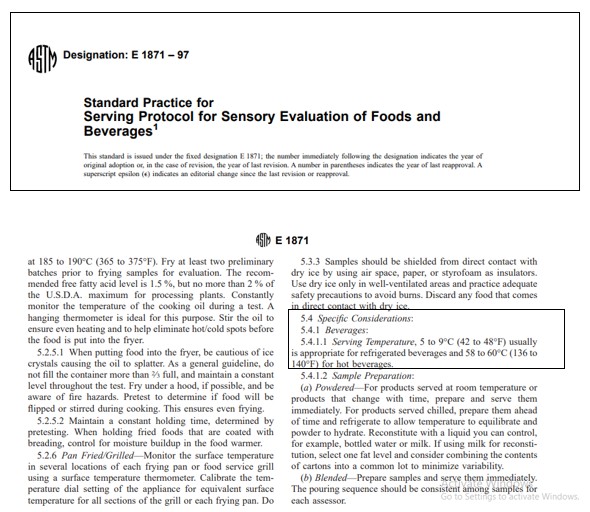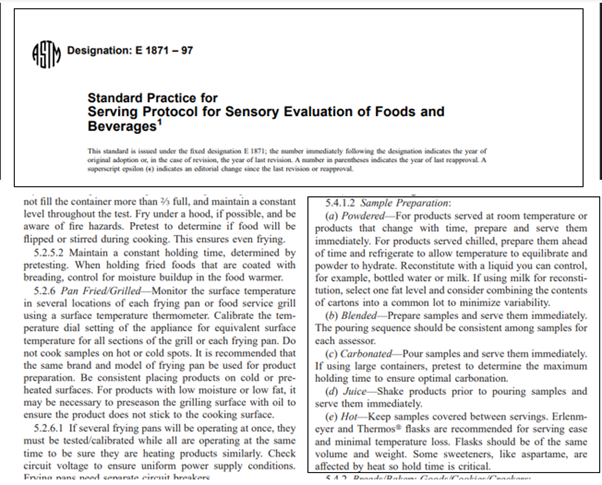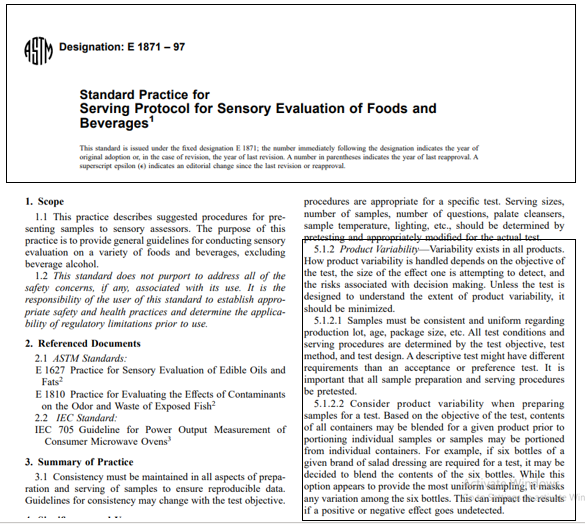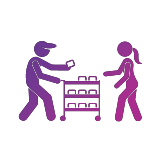SENSORY ACCEPTABILITY STUDY
Regulations
Nutraceuticals Regulations FSSAI
Interesting Topics
QUESTION AND ANSWER
How Should Beverages Be Handled in Sensory Evaluation?
(Based on ASTM E1871 – Standard Practice for Sensory Evaluation of Foods and Beverages)
1. What is the correct serving temperature for beverages during sensory testing?
Recommended serving temperatures as per ASTM E1871, Section 5.4.1.1, are:
- 5–9°C (42–48°F) for refrigerated beverages
- The range of 58–60°C (136–140°F) for hot beverages
Maintaining a consistent temperature within these ranges is critical, as fluctuations can influence flavor perception and skew results.
Example:
If a chilled citrus soda is served at a temperature higher than 9°C, it can lose its fizz faster with an accompanying taste that seems sweeter. This change masks the sourness and changes how the drink’s taste is normally experienced.
Likewise, coffee served at only 50°C instead of the recommended 58-60°C will seem weaker in smell and flavor because of production in heat.
Because of this, ASTM E1871 recommends very stringent temperature control, so that results come out reliably and consistently every time.
[Reference: ASTM International. (2008). Standard Guide for Sensory Evaluation of Beverages (ASTM E1871 – 95(2008)) (See Section 5.4.1.1).]

2. How should different types of beverages be prepared for sensory testing?
ASTM E1871, in Section 5.4.1.2, contains appropriate provisions related to beverage types such as:
(a) Powdered Beverages
- If served at room temperature or subject to time-based changes (like separation), they should be prepared and served immediately.
- For chilled beverages, prepare ahead and refrigerate to allow proper hydration and temperature stabilization.
- Always reconstitute with a controlled liquid (e.g., bottled water or milk with a known fat level), and consider combining multiple units (e.g., cartons) to reduce variability.
Example:
When testing a powdered protein shake meant to be served cold, it should be prepared with chilled bottled water ahead of time and refrigerated, so the powder fully dissolves, and the temperature stabilizes. If served at room temperature, it must be mixed and served right away to avoid separation.
(b) Blended Beveragess
- All of them should prepare and serve directly.
- Provide a prearranged order of pouring for each evaluator for the prevention of accidental bias.
Example:
In case of a fruit smoothie, blend and serve at once to every panelist. Stick to a pre-arranged pouring order to avert prejudice from textural or temperature changes occurring in between samples.
(c) Carbonated Beverages
- Pour and serve instantly to ensure carbonation.
- When using large containers, the pretest has determined the maximum holding time that maintains carbonation integrity.
Example:
While testing the cola, pour it right after opening and serve promptly to maintain carbonation. If you have a 2 L bottle, first do a pretest and note how long the bottle stays open before it loses the fizz.
(d) Juices
- Shake before pouring to make sure all pulp or sediment is uniformly distributed in the juice.
- Immediately serve after shaking.
Example:
During testing for orange juice with pulp, shake vigorously before pouring so that the pulp disperses evenly. Serve immediately so that it remains consistent for all evaluators.
(e) Hot Beverages
- To save the temperature, keep covering between servings.
- Same volume and weight; standardized containers such as Erlenmeyer or Thermost flasks serve as normalized conditions for serving.
- Note: Some sweetening materials such as aspartame deteriorate by heating, so holding time should be less to maintain sweetness and flavor true to nature.
Example:
For black tea aspartame testing, serve in identical thermos flasks to maintain the temperature and volume. Since aspartame decomposes with heat, it should not be kept for a long time before serving; else, it will taste less sweet than intended.
[Reference: ASTM International. (2008). Standard Guide for Sensory Evaluation of Beverages (ASTM E1871 – 95(2008)) (See Section 5.4.1.2).]

3. Why does this level of detail matter in beverage testing?
Because even small inconsistencies—like serving a hot beverage too cool or letting carbonation fade—can drastically alter the sensory experience. ASTM E1871 emphasizes repeatability, precision, and minimizing unintended variables to ensure credible, science-backed results.
Example:
A green tea sample served at 60 degrees centigrade and another at 50 degrees centigrade may smell less and taste more bitter from the cooler temperature, despite all being of equal quality.
In a lemon soda test, given one sample remains exposed to air too long, it may lose its power to fizz and feel less refreshing, even with the same recipe.
Such small changes could rupture the results, hence the need for strict controls during testing as most stated in ASTM E1871.
[Reference: ASTM International. (2008). Standard Guide for Sensory Evaluation of Beverages (ASTM E1871 – 95(2008)) (See Section 5.1.2).]

Developed by ASTM Committee E-18, this standard provides detailed procedural guidance to ensure consistency and scientific accuracy in sensory evaluation.
Need help designing a beverage sensory study that meets global standards?
Our experts at Food Research Lab can guide you through setup, protocol design, and data interpretation—aligned with ASTM E1871 and other leading frameworks.
Contact us today for consultation or lab support.

Let’s create something Innovative and Delicious together
Food Research Lab strives for excellence in new Food, Beverage and Nutraceutical Product Research and Development by offering cutting edge scientific analysis and expertise.




